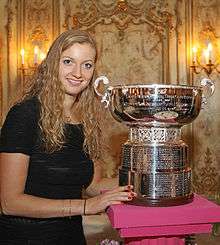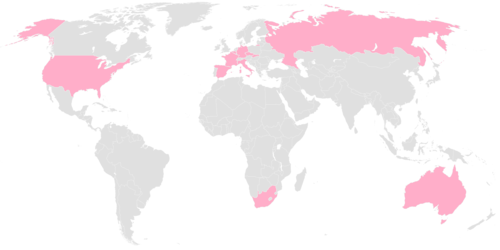Fed Cup
The Fed Cup is the premier international team competition in women's tennis, launched in 1963 to celebrate the 50th anniversary of the International Tennis Federation (ITF). The competition was known as the Federation Cup until 1995. The Fed Cup is the world's largest annual women's international team sports competition in terms of the number of nations that compete.[2][3] The current Fed Cup Chairperson is Katrina Adams.[4]
| Current season, competition or edition: | |
 | |
| Sport | Tennis |
|---|---|
| Founded | 1963 |
| No. of teams | 8 (World Group) 99 (total 2016)[1] |
| Countries | ITF member nations |
| Most recent champion(s) | |
| Most titles | |
| Official website | fedcup.com |
The relatively small nation of Czech Republic dominated the Fed Cup in the 2010s, as the Czechs won six of ten competitions in the decade. The men's equivalent of the Fed Cup is the Davis Cup, and the Czech Republic, Australia and the United States are the only countries to have held both Cups at the same time.
History
In 1919, Hazel Hotchkiss Wightman had an idea for a women's team tennis competition. This was not adopted but she persisted, presenting a trophy at the 1923 annual contest between the United States and Great Britain, named the Wightman Cup.
Nell Hopman, wife of the legendary Australian Davis Cup Captain Harry Hopman, later took up Mrs Wightman's original idea. In 1962, a British resident of the United States, Mary Hardwick Hare, presented a dossier proving that support for such an event was overwhelming, persuading the ITF that it was a 'good idea' to have a team championship played over one week in a different venue each year. 40 years after Wightman's idea of a women's Davis Cup, it became a reality. In 1963, the ITF launched the Federation Cup to celebrate its 50th anniversary. Open to all nations the competition became a resounding success.
The inaugural event attracted 16 countries. The competition was supported by the top players right from the start. Held at the Queen's Club, in London, the first contest was between Australia and the United States. Grand Slam champions Darlene Hard, Billie Jean King, Margaret Smith and Lesley Turner all proudly representing their country on court. The United States would emerge the champion nation in the opening year. However, it was to be Australia in the early years, winning seven of the next eleven championships. Around 1980 the United States was able to establish some significant mark on the competition setting in future years a very high standard for others to compete against.

The first Federation Cup had attracted 16 entry teams, despite no prize money and teams having to meet their own expenses. When sponsorship became available, the number of teams expanded dramatically, first by the Colgate Group in 1976, and, from 1981 to 1994 by the Japanese communications and computer giant NEC. In 1994, there were 73 nations competing, with the host nation of a Federation Cup week was now being required to build a special tennis complex, giving rise to what became known as the Federation Cup "legacy." The additional costs of each event could be offset with the host nations viewing their involvement as providing an opportunity to boost their national game.
For the 1992, a regional group qualifying format was introduced. In 1995, the tournament's name was shortened to the Fed Cup, and a new home-and-away format was adopted as trialled by the Davis Cup, so that women could play for their country in their own country. There have been a number of smaller changes to the format since 1995. The format change implemented in 2005 incorporates an eight Nation World Group I and eight nation World Group II both playing home-and-away over three weekends throughout the year. Three regional groups compete and there are promotions and relegations based on results.
Format
Tournament
While many nations enter the Fed Cup each year, only 16 countries qualify for the elite World Group and World Group II each year (eight in World Group and eight in World Group II).[5]
They reach World Group and World Group II as follows:
- (a) World Group - the four nations that win their World Group first round tie remain in the World Group for the following year. First round losers contest the World Group Play-offs against the four winning nations from World Group II to determine relegation/promotion for the following year's competition. (The four nations that win World Group Play-offs will be in the World Group the following year, while the four losers will start the following year in World Group II.)
- (b) World Group II - the four nations that win their World Group II ties will compete in the World Group I Play-Offs to determine relegation/promotion for the following year, as described above. Similarly the four nations that lose their World Group II ties will face winning nations from Group I Zonal competitions, in the World Group II Play-offs, to determine relegation/promotion. (The four nations that win their World Group II Play-offs will be in World Group II the following year, while the four losers will begin the next year in Group I Zonal events.)
Once in the World Group or World Group II, four nations will be seeded in each. The decision as to which nations will be seeded is made by the Fed Cup Committee, according to the ITF Fed Cup Nations Ranking.
At the levels below the World Group and World Group II, the Fed Cup nations compete in Zonal Competition events, which are split into three zones: The Americas Zone, the Asia/Oceania Zone and the Europe/Africa Zone. In each zone there are two groups, Group I being the higher and Group II the lower, except for the Europe/Africa Zone, which also has a Group III.
Within the Group zonal regions, teams are split into pools and play against each other in a round robin format. The exact format of each Group event, and promotion and relegation between them, varies according to the number of participating teams. Two teams are always promoted from Europe/Africa Group I to that year's World Group II Play-Offs, while one team each go to the World Group II Play-Offs from Americas Group I and Asia/Oceania Zone Group I.
Current structure
This structure has been implemented since 2016.[5][6]
| Level | Group(s) | ||
|---|---|---|---|
| 1 | World Group I 8 countries | ||
| World Group I Playoff 4 countries from World Group I + 4 countries from World Group II | |||
| 2 | World Group II 8 countries | ||
| World Group II Playoff 4 countries from World Group II + 2 countries from Group One Euro/African Zone | |||
| 3 | Group One American Zone 8 countries |
Group One Euro/African Zone 15 countries |
Group One Asia/Oceania Zone 7 countries |
| 4 | Group Two American Zone 11 countries |
Group Two Euro/African Zone 7 countries |
Group Two Asia/Oceania Zone 15 countries |
| 5 | Group Three Euro/African Zone 16 countries |
||
Ties
In World Group and World Group II, and World Group and World Group II Play-Off ties, each tie is contested in a best of five matches format, and is played across two days. On the first day there are two singles matches, and then the reverse singles matches take place on the following day. The final match is a doubles.
In Zonal Groups I, II and III, ties are played over the best of three matches (two singles and a doubles).
The First Round Ties in the World Group and World Group II are played on a home and away knock-out basis, and take place over a weekend in the early part of the year.
World Group Semifinals and Final are played over on a home and away knock-out basis, and take place over a weekend in July (Semifinals) and September (Final).
Play-Off ties for World Group and World Group II will also be played on a home and away knock-out basis taking place in July.
The choice of ground for First Round, Semifinals and Play-Off ties is decided by lot or goes automatically to one of the competing nations.
As Groups I, II and III are played in a round robin format in all three zones, each event takes place at a single venue over one week. These are held in the first half of the year (to allow promotion of teams to the World Group II Play-Off ties in second half of the year), and dates and venues are decided by the Fed Cup Committee.
Records and statistics
Performance by team
+ — also won Junior Fed Cup title
Team records
- Consecutive titles
- All-time: 7, United States, 1976–1982
- Consecutive finals appearances
- All-time: 8, Australia, 1973–1980
- Most number of games in a tie
- Years present in World Group
- France 51
- United States 50
- Italy 49
- Germany 46
- Belgium 42
- Australia 41
- Spain 40
- Czech Republic 39
- Switzerland 37
- Japan 34
- Netherlands 34
- Russia 34
- Argentina 33
- Austria 32
- Canada 32
- Great Britain 31
- Sweden 29
- Denmark 26
- New Zealand 23
- Indonesia 22
- South Africa 20
- Brazil 19
- Israel 19
- South Korea 19
- Hungary 18
- Mexico 18
- Bulgaria 17
- Norway 17
- Yugoslavia 17
- China 16
- Greece 16
- Poland 14
- Romania 13
- Ireland 12
- Finland 10
- Luxembourg 10
- Slovakia 10
- Chile 9
- Chinese Taipei 9
- Croatia 8
- Uruguay 8
- Philippines 6
- Portugal 6
- Colombia 5
- Hong Kong 5
- Peru 5
- Thailand 4
- Paraguay 3
- Serbia 3
- Latvia 2
- Slovenia 2
- Ukraine 2
- Belarus 1
- Dominican Republic 1
- Ecuador 1
- Egypt 1
- Iran 1
- Malta 1
- Morocco 1
- Venezuela 1

Individual records
- Youngest player
- Denise Panagopoulou; Greece; 12 years, 360 days1
- Oldest player
- Gill Butterfield; Bermuda; 52 years, 162 days
- Most rubbers played
- 100, Arantxa Sánchez Vicario, Spain
- Most ties played
- 74, Anne Kremer, Luxembourg
- Most rubbers won
- Total: 72, Arantxa Sánchez Vicario, Spain
- Singles: 50, Arantxa Sánchez Vicario, Spain
- Doubles: 38, Larisa Neiland, Soviet Union/Latvia
- Longest rubber
- 2016 World Group: Richel Hogenkamp defeated Svetlana Kuznetsova in 4 hours, 7-6(7-4), 5-7, 10-8.[8]
- Most successful captain
1Players must now be aged 14 and over
Heart Award
The Heart Award is ITF's annual "MVP" award related to Fed Cup, which aims to recognise players who have represented their country with distinction, shown exceptional courage on court and demonstrated outstanding commitment to the team.[10] The award was inaugurated in 2009.
Current rankings
For more information, see ITF Rankings
| ITF Fed Cup Nations Ranking, as of 11 November 2019[11] | |||
|---|---|---|---|
| # | Nation | Points | Move† |
| 1 | 25,280.00 | ||
| 2 | 22,700.00 | ||
| 3 | 20,115.00 | ||
| 4 | 14,160.00 | ||
| 5 | 11,880.00 | ||
| 6 | 7,562.50 | ||
| 7 | 6,822.50 | ||
| 8 | 5,532.50 | ||
| 9 | 4,735.00 | ||
| 10 | 4,050.00 | ||
| 11 | 4,035.00 | ||
| 12 | 3,782.50 | ||
| 13 | 3,630.00 | ||
| 14 | 3,455.00 | ||
| 15 | 3,417.50 | ||
| 16 | 3,080.00 | ||
| 17 | 2,482.50 | ||
| 18 | 2,280.00 | ||
| 19 | 2,095.00 | ||
| 20 | 2,047.50 | ||
†Change since previous ranking update
Broadcasters
| Country/region | Broadcaster | |||
|---|---|---|---|---|
| Free | Pay | Summary | Ref | |
| International | ITF | Qualifiers matches live on Fed Cup TV | [12] | |
| Nine | beIN Sports |
|
[13] | |
| TBA | ||||
| TyC Sports | Selected matches live | |||
| Belteleradio | Belarus matches only | |||
| VRT (Dutch) | Belgium matches only | |||
| RTBF (French) | ||||
| DAZN | Selected matches, including all Brazil team and at the finals round | [14] | ||
| Sportsnet | [15] | |||
| Win Sports | [16] | |||
| DOSB | Live on Sportdeutschland.TV | |||
| SuperTennis | Selected matches live | |||
| Wowow | Selected matches live, including Japan team | |||
| QAZTRK | ||||
| LTV7 | Lattelecom |
|
||
| Ziggo | Selected matches, including all Netherlands team and at the finals round on Ziggo Sport | |||
| RCS & RDS | Selected matches live, including Romania team | |||
| Telekom Romania | ||||
| Match TV | Selected matches live, including Russia team | |||
| RTVS | Slovakia matches only, live on :2 | |||
| RTVE | Spain matches only | |||
| SRG SSR | Switzerland matches only | |||
| BBC | GB matches only | |||
| LTA | ||||
| Tennis Channel | Selected matches live | |||
See also
References
- "Fed Cup Number of Nations Participating per Year". www.fedcup.com. ITF. Retrieved 15 January 2016.
- Glenday, Craig, ed. (2008). Guinness World Records 2008. Bantam Books. pp. 497. ISBN 9780553589955.
- "About Fed Cup by BNP Paribas". itftennis.com. ITF. Retrieved 13 January 2016.
- "FED CUP COMMITTEE". Fed Cup. Retrieved 26 Jan 2018.
- "Fed Cup Format". www.fedcup.com. ITF. Retrieved 13 January 2016.
- "Fed Cup Rules & Regulations". www.fedcup.com. ITF. 13 January 2016. Retrieved 13 January 2016.
- "Fed Cup Champions". www.fedcup.com. ITF. Retrieved 13 January 2016.
- Erik Gudris (6 February 2016). "Hogenkamp Wins Longest Ever Fed Cup Match Over Kuznetsova". Tennisnow.com. Retrieved 6 February 2016.
- Strength in Depth the Key for Five-Star Czech Republic, WTA official website, 14 November 2016
- "Fed Cup Heart Award". www.fedcup.com. ITF. Retrieved 13 January 2016.
- "Nations Ranking". fedcup.com. International Tennis Federation.
- "WHERE TO WATCH THE FED CUP QUALIFIERS". Fed Cup. 2020-02-03. Retrieved 2020-02-05.
- "Tennis Australia and Nine Network sign landmark rights deal". Tennis Australia. Retrieved 2020-02-05.
- "DAZN ANUNCIA TRANSMISSÃO EXCLUSIVA DA 1ª FASE DA FED CUP DISPUTADA NO BRASIL". DAZN (in Portuguese). 2020-01-20. Retrieved 2020-02-05.
- "Tennis on TV". Tennis Canada. Retrieved 2020-02-05.
- "Win Sports | El canal oficial de la Liga y todo el Fútbol Profesional Colombiano". www.winsports.co. Retrieved 2020-02-05.
